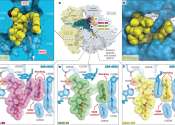Last update:
Biochemistry news

Some gut bacteria could make certain drugs less effective, study indicates
A study published in Nature Chemistry by researchers from the University of Pittsburgh and Yale University shows how common gut bacteria can metabolize certain oral medications that target cellular receptors called GPCRs, ...
Biochemistry
Apr 3, 2025
0
36

Catalytic system turns biomass waste to renewable chemical stock
Researchers at Umeå University in Sweden, in collaboration with scientists from Finland, Vietnam, India, and Italy, have developed a catalytic system to convert lignin structures into highly valuable chemicals. This innovative ...
Biochemistry
Apr 2, 2025
0
0

Organogold(III) complex accumulates in mitochondria of lung cancer cells, opening up new treatment avenues
Precious metals are not merely ornaments; they are also important components of pharmaceuticals, like the antitumor drug cisplatin. Recently, the search for alternatives with improved activity has begun to focus on gold.
Biochemistry
Apr 2, 2025
0
0

Binding to surface sugars enhances omicron variant's cell attachment, researchers discover
Researchers at Umeå University have discovered that the SARS-CoV-2 variant omicron has developed a stronger binding to human lung cells through optimized interaction with heparan sulfate, a sugar molecule on the cell surface. ...
Biochemistry
Apr 1, 2025
0
0

Sustainable biomanufacturing: Key to India's green transition
In the battle against climate change, the role of chemistry and the chemical industry is often overlooked. As India accelerates its industrial growth, it must embrace sustainable biomanufacturing and green chemistry not just ...

Evaluating the health effects of bioactive compounds obtained from plants
Fruits and plant extracts contain bioactive compounds that can help treat or prevent diseases. To characterize and understand their mechanism of action, researchers from universities and research institutions in Brazil and ...
Biochemistry
Mar 31, 2025
0
0

Active compounds in Piper longum fruits show potential for functional foods and medicine
Mature or nearly mature fruits of Piper longum are used as a spice, valued for their commercial and industrial applications, as well as in traditional Chinese medicine for their multiple effects, such as dispelling cold and ...
Biochemistry
Mar 28, 2025
0
96

Nanofiltration system separates valuable industrial chemicals from cattle manure
A collaboration between chemical engineers and animal scientists has created a system for recovering valuable industrial chemicals from animal waste, representing a major step towards circularity and environmental sustainability.
Biochemistry
Mar 28, 2025
0
2

Novel enzyme can extract valuable compounds from plant waste using a green chemistry approach
About 98% of lignin created as a forestry by-product from plants is discarded, but a new enzyme could be the key to extracting high-value molecules from this waste using a green chemistry approach.
Biochemistry
Mar 27, 2025
0
15

How calcium may have unlocked the origins of life's molecular asymmetry
A new study led by researchers at the Earth-Life Science Institute (ELSI) at the Institute of Science, Tokyo, has uncovered a surprising role for calcium in shaping life's earliest molecular structures. Their findings suggest ...
Biochemistry
Mar 27, 2025
0
34

New method for selective protein modification in living systems could advance cancer research
A research team has developed an innovative technique that enables precise modification of specific proteins within complex biological environments. The work was led by Professor Seung Soo Oh and Dr. Hyesung Jo from the Department ...
Biochemistry
Mar 26, 2025
0
1

Study unravels mystery of cancer-fueling enzyme, which could lead to new therapies
For organs to develop, grow and regenerate, cells must proliferate. But when that process goes awry, leading to uncontrolled cell growth, cancer can emerge.
Biochemistry
Mar 25, 2025
0
75

Dynamic density functional theory offers new approach to understanding protein–membrane interactions
Proteins interacting with cell membranes play a vital role in countless biological processes, from how cells communicate to how they respond to external signals like hormones or medications. Understanding these interactions ...
Biochemistry
Mar 25, 2025
0
2

Superoxide's role in enzyme-driven drug synthesis uncovered
Enzymes, the core catalysts in life, drive critical biological processes ranging from metabolic regulation to energy conversion. Evolved over billions of years, these versatile molecular machines not only serve as foundational ...
Biochemistry
Mar 25, 2025
0
0

Hydrophilic coating makes for unflappable golf balls
The upcoming U.S. Open has professional golfers and spectators looking forward to getting on the green. But the grass's condition, regardless of a player's skill, can drastically skew the chances of a winning putt. Now, scientists ...
Biochemistry
Mar 25, 2025
0
2

Chemical analysis of Codonopsis lanceolata roots shows significant vasodilatory effects from compound
A research group led by Associate Professor Takashi Kikuchi and Professor Wei Li from the Department of Pharmacognosy at the Faculty of Pharmaceutical Sciences, Toho University, along with Professor Atsushi Sugiyama from ...
Biochemistry
Mar 24, 2025
0
28

Advances to prevent food fraud in the consumption of virgin olive oil and pine nuts
Food fraud occurs when products that do not meet consumer expectations reach the market and, in extreme cases, this can lead to health problems. To combat this misleading and critical practice in the food sector, a team from ...
Biochemistry
Mar 24, 2025
0
0

Researchers achieve de novo biosynthesis of plant lignans using synthetic yeast consortia
Lignans are low molecular weight polyphenolic compounds with important antitumor and antiviral properties. However, their low amounts in medicinal plants and complex structures make sustainable production through plant extraction ...
Biochemistry
Mar 24, 2025
0
1

Decades-long quest leads to new antibiotic compounds
A team of chemists, biologists and microbiologists led by researchers in Arts & Sciences at Washington University in St. Louis has found a way to tweak an antimalarial drug and turn it into a potent antibiotic, part of a ...
Biochemistry
Mar 24, 2025
0
20

New drug delivery method promises months-long effects with fewer injections
MIT engineers have devised a new way to deliver certain drugs in higher doses with less pain, by injecting them as a suspension of tiny crystals. Once under the skin, the crystals assemble into a drug "depot" that could last ...
Biochemistry
Mar 24, 2025
0
66
Other news

Young plants' vulnerability linked to growth-energy trade-off

Artificial sweetener shows surprising power to overcome antibiotic resistance

Scientists reveal new toxin that damages the gut

Ancient lakes and rivers unearthed in Arabia's vast desert

Hot Schrödinger cat states created

Beyond photorespiration: A systematic approach to unlocking enhanced plant productivity

Planarian worms can regenerate into a more youthful version of themselves

Massive Jupiter storm churns ammonia deep into planet's atmosphere

Honda to test renewable tech in space soon

Bacteria's viral defense mechanism linked to antibiotic resistance





































































